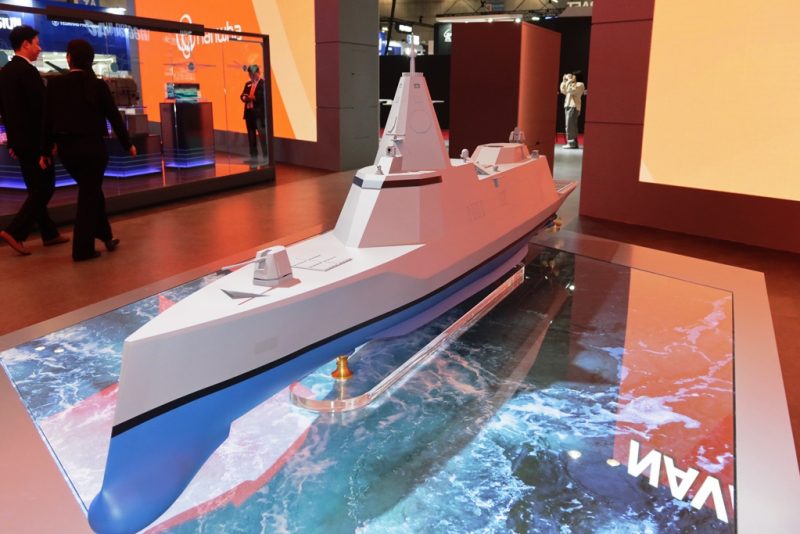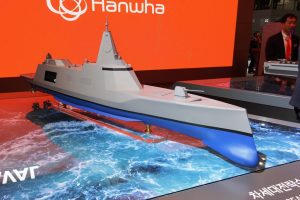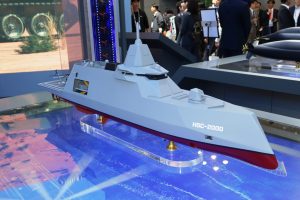ADEX 2025 – Hanwha Ocean unveils two new concept projects for surface combatant ship, heavily based on Artificial Intelligence
At the Seoul defence exhibition, artificial intelligence, or AI in short, has reigned supreme, cited in practically every future program involving air, land, and naval systems, as in the case of the two concept surface ships proposed by Hanwha Ocean
Mostly aimed at the export market is the Ocean-74FN, a 7,400 tonnes displacement combatant ship that features an inverted bow. The ship by Hanwha Ocean is 145.6 metres long with an 18.8 metres beam and is powered by a gas turbine propulsion system on two shafts with five-blade propellers that allows a maximum speed of 27 knots. The Ocean-74FN is fitted with a considerable array of offensive and defensive weapon systems that make it ready to operate in full spectrum scenarios ranging from naval warfare to asymmetric situations.
Its communication systems make it fully part of a networked system enabling the ship to launch precision strikes on targets provided by external sensors, coordinated by higher echelon commands. It is fitted with a resilient command and control system, that exploits a wide area comms coverage thanks to its capacity to link into a low earth orbit satellite system. The ship, which features a stealth design, is fitted for operating in cooperation with unmanned surface and air vehicles.
From bow to stern, we find a 127 mm gun followed by a 48-cell vertical launcher; this would be made of two blocks of six each KVLS-II 4-cell modules, EDR On-Line understood. Developed and produced by Hanwha Aerospace in collaboration with Korean governmental entities such as the Defence Acquisition Programme Administration, the Agency for Defence Development, and the Defence Technology Support Agency, it allows to launch weapons of increasing diameter compared to the KVLS-I. Hanwha Aerospace announced the completion of the development in late September 2025, the first system to be installed Aegis destroyer KDX-III Batch-II, which was delivered to the ROK Navy at the end of last year. The ROK Navy will also use it on future KDDX destroyers, the company also looking at the export market, hence its presence on the Ocean-74FN which is looking at foreign customers.
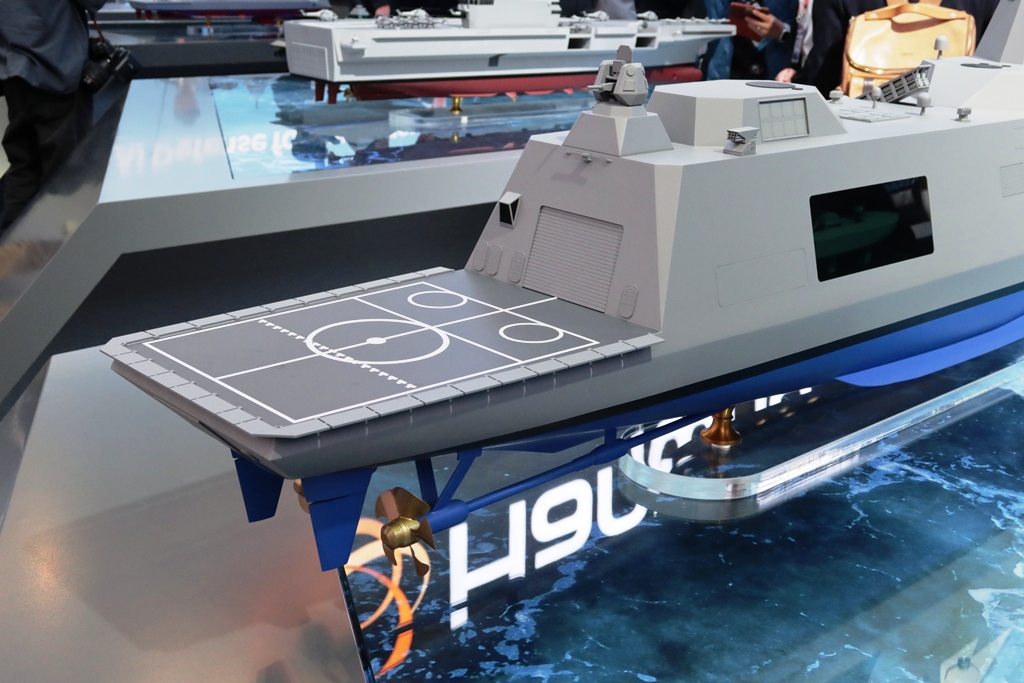
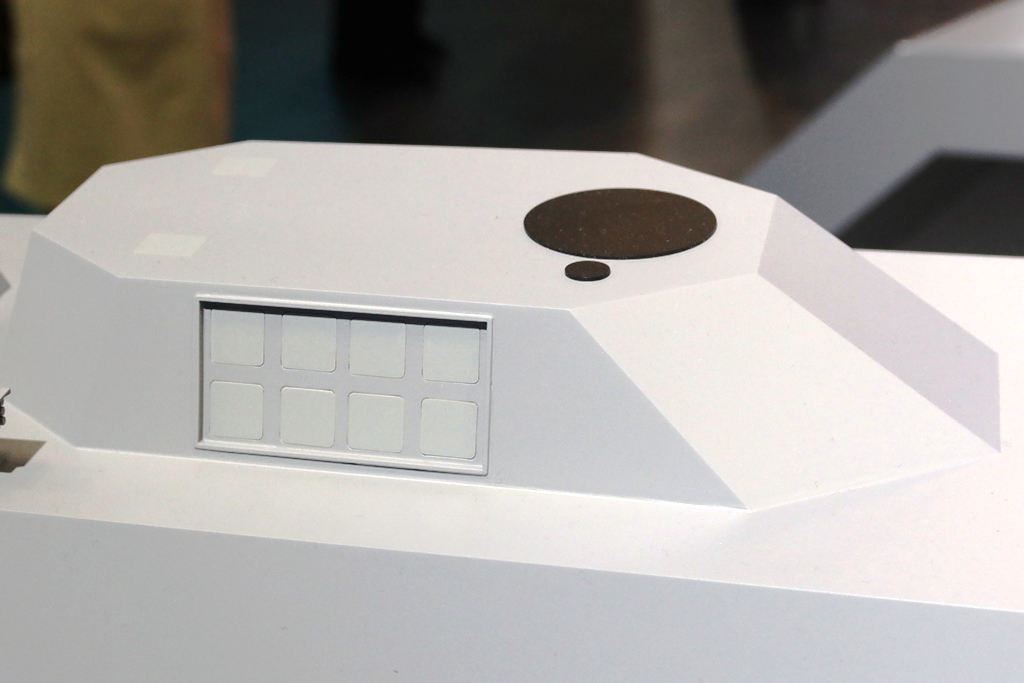

A laser gun could be seen on the superstructure, over bridge roof, just under the navigation radar. On the superstructure, behind the main mast, we find two quadruple launchers for surface-to-surface missiles, looking respectively port and starboard; in normal time these are lowered, reducing the radar cross section, and they are raised only when launch is imminent. Moving back, still on top of the superstructure, we find four more KVLS-II modules, hosting further 16 missiles, while in the small sponson hosting the turbines exhaust, we could see two four tube rows openings per side, allowing the launch of small UAVs, decoy launchers being also visible on the hangar roof, which also hosts a close in weapon system at the rear. At stern the flight deck can operate a medium helicopter or UAVs. At the rear of the superstructure, port and starboard, we find a mission bay that can host one Modular Unmanned Surface Vessel each. As for sensors, for underwater warfare the Ocean-74FN is fitted with a bow mounted sonar and a towed array sonar, an AESA four face flat radar being visible on the main mast, the latter provided by Hanwha Systems which is also responsible for the combat management system. Artificial Intelligence algorithms are used throughout the ship, which allows to decrease the crew from typical 200 people to only 70.
Artificial intelligence and inverted bow are also features of a smaller ship unveiled at ADEX, the Smart Battleship or HSC-2000, a 2,000 tonnes next generation offshore patrol vessel. The stealth shape remembers that of the Ocean-74FN, weaponry visible on the model including a 76 mm bow-mounted gun followed by a 2 x 8 cells vertical launcher ahead of the superstructure, EDR On-Line understanding this might be the MBDA VL MICA air defence system. On top of the superstructure, we find two twin launchers for antiship missiles, possibly from Kongsberg, while the stern flight deck can operate helicopters of the Seahawk class; the small hangar is unable to host manned aircraft, and it is used for UAVs, while the mission bay on the starboard side can be used to launch unmanned surface and underwater vessels, as well as RHIBs. These unmanned platforms operate in strict cooperation with the ship thanks to a MUM-T solution developed by Hanwha, and enhance the HSC-2000 survivability, increasing its reconnaissance reach as well as its lethal range.
The core of the Smart Battleship is the AI-based integrated ship management system that includes the Combat Management System, the Integrated Bridge System and the Integrated Machinery Control System, an all-in-one solution that allows to drastically reduce the ship’s crew members, from the 60-80 complement of a conventional ship of that size to only 34 people, 16 extra berthing being available for special teams. The ship sensors, namely the four face AESA radar installed on the pyramidal mast, and distributed sensors fitted to unmanned platforms, together with automatic target recognition algorithms, will ensure maximum situational awareness and will allow optimising defensive and offensive operations.
The Smart Battleship is fitted with a CODAD diesel-based propulsion system that power two shafts, maximum speed being 24 knots, while range at 15 knots cruise speed is 5,000 nm. A bow thruster ensures maximum manoeuvrability, fin stabilisation allowing operating the ship systems in high seas. The HSC-2000 is modular and scalable, therefore dimensions provided might vary in the future, currently the project being for a 91.5 metres long ship with a 14 metres beam and a 3.8 metres draft. Hanwha Ocean is cooperating with the ROK Navy to evolve the Smart Battleship concept in a real ship, the launch of a first-of-class being forecasted in five years, the Korean shipyard looking of course also beyond national borders.
Photos by P. Valpolini

